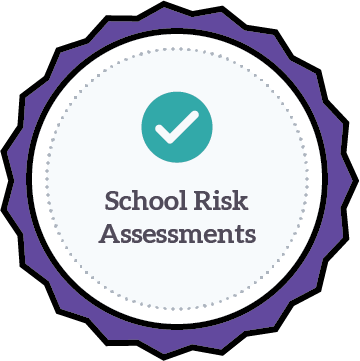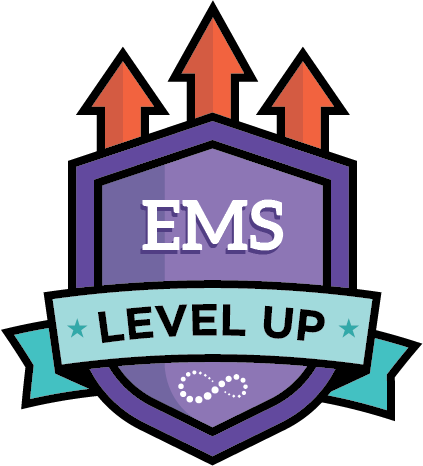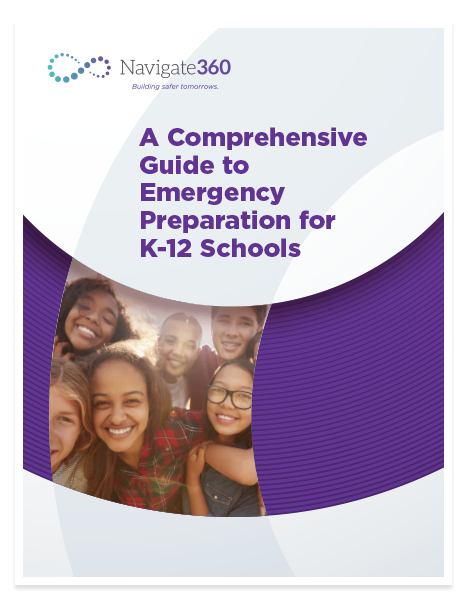A Comprehensive Guide to Emergency Preparation for K-12 Schools

Emergencies are unexpected and can happen at any time and place, including at schools. There are various types of emergencies, including natural disasters, medical emergencies, and active shooter threats, and schools need to be prepared to handle all of them. Because of this, having a plan in place for any and all emergencies is crucial for school security and safety officials. Concerningly, only 37% of teens 16-17 years old currently feel their school has a comprehensive plan to deal with an emergency, according to a 2021 poll conducted by Navigate360 and John Zogby Strategies.
While having a plan is a step in the right direction, any directives need to be comprehensive and fully fleshed out. In order for Emergency Operations Plans (EOPs) to be effective, they must address what happens before, during, and after an emergency or critical event and be updated regularly to maintain compliance. These goals can be accomplished by utilizing Navigate360’s Emergency Management Suite (EMS).
The Importance of District-Wide Preparation for All-Hazard School Emergencies
School preparation efforts must encompass a wide range of hazards such as active shooter threats, environmental hazards, severe weather, natural disasters, mental health and medical emergencies, communicable diseases, cybersecurity threats, and more. The COVID-19 pandemic means the measures needed to create safe and healthy schools are more vital—but also less practiced—than ever before.
Each school in a district shouldn’t be standing alone in its efforts to be ready for events like these, though. Preparing schools for all types of emergencies should span the entire district because:
- A district-wide approach ensures that the plan is responsive to the needs of all schools within the district.
- Having a district-wide school safety plan provides the framework for each building-level emergency response plans within individual schools.
- Consistency across schools helps all staff better understand and execute the emergency plans and protocols.
Furthermore, when developing an all-hazard emergency preparation plan, school safety and security officials should be familiar with the Presidential Policy Directive (PPD) 8 and its five mission areas:![]()
- Prevention – The actions schools take to prevent a threatened or actual incident from occurring.
- Protection – Ongoing actions that protect students, teachers, staff, visitors, networks, and property from a threat or hazard.
- Mitigation – Capabilities necessary to eliminate or reduce the loss of life and property damage by lessening the impact of an event or emergency.
- Response – Stabilize an emergency once it has already happened or is certain to happen in an unpreventable way; establish a safe and secure environment; save lives and property; and facilitate the transition to recovery.
- Recovery – Capabilities necessary to assist schools affected by an event or emergency in restoring the learning environment.
Prevention, Protection, and Mitigation activities generally occur before an incident; Response activities occur during an incident; and Recovery activities can begin during an incident and occur after an incident. As of 2019, at least 43 states and the District of Columbia require a school safety plan in statute or regulation so be sure that your school district is forming its EOP according to state guidelines.
Surviving the Aftermath
Recovery extends far beyond the first few days after an emergency or critical event. District-wide emergency preparations should also include proactive strategies that consider the aftermath of school emergencies, accounting for potential survival stress reactions and mentalities among traumatized students and staff. This includes having support systems, including social workers and school psychologist resources, and closely examining the school culture and climate post-emergency.

How to Create a Comprehensive Emergency Preparation Plan for Schools District-Wide

A comprehensive emergency preparation plan for your school district should include beginning-to-end guidance on how to respond, communicate, and resolve emergency situations. It can be especially helpful to form a collaborative, cross-functional team for emergency planning, made up of personnel such as administrators, educators, school psychologists, nurses, facilities managers, transportation managers, and family services representatives. This planning team should also include community partners such as first responders, law enforcement officers, emergency medical services, and school resource officers.
Navigate360’s Emergency Management Suite accommodates a comprehensive approach to planning by capturing activity in the event of a critical incident by way of solution modules, facilitating clear communication with law enforcement to reduce response time during emergencies when every second counts. Our EMS can also be integrated seamlessly with our Visitor and Volunteer Management software to create a full Safety & Security Suite that provides end-to-end protection.
What’s Missing from Your District’s K-12 Emergency Operating Procedures?
According to SchoolSafety.gov, EOPs should be reviewed and updated at least every two years and many states have requirements around how often plans should be reviewed. Regular review helps ensure that your emergency preparation plan is up-to-date and contains vital and current information reflecting any new threats, laws – such as Alyssa’s Law – and any other relevant changes like security of school building or needs of the community. A major example of a recent change is the COVID-19 pandemic—EOPs that have not been reviewed in the past two years will have no mention of COVID-19 and the protocols surrounding this health development.
School Safety Plans & Security Audits
School districts’ emergency operations plans should indicate beginning-to-end guidance on how to respond to, communicate about, and resolve incidents. Step-by-step procedures should be included for students, teachers, and other school personnel. It is also important for your school district’s EOP to meet all state-level compliance requirements.
Navigate360’s Emergency Management Suite can aid school security and safety officials in developing school safety plans. Our Safety Plan Wizard is friendly and interactive and replaces dense documentation with quick access to vital information. This technology records annual plans and updates for district visibility. There are even state-specific templates for multi-hazard EOPS based on federal and state standards to make planning even easier. The Emergency Management Suite is integrated with 911Cellular’s panic button technology to ensure that Alyssa’s Law-compliant alert notifications to first responders are also delivered to school security personnel so they can use the EMS features to respond and follow reunification processes.


Security Audits
Complete and document audits based on state or customized templates.

School Risk Assessments
A team of certified professionals assess risk on-site and delivers a comprehensive report outlining any gaps in safety and security at each school.
School Emergency Drills
Since the pandemic started, many schools have gone without an emergency drill for more than a year. However, these drills should not be overlooked or forgotten, as research has found drills implemented according to best practices could increase students’ knowledge and skills for responding in an emergency, without increasing their anxiety1.
As your schools return to in-person learning and re-initiate emergency drills, the Emergency Management Suite can aid you by keeping comprehensive electronic drill logs. This feature facilitates Disaster Drill Management, in which users can manage yearly district requirements, schedule drills, manage reminders, log drill info, search for specific exercises, keep and measure statistics, and print completed forms, ensuring any state requirements are met and schools remain compliant.

Staying Compliant with Enhanced Safety Standards in Alyssa’s Law

Named for Alyssa Alhadeff, a 14-year-old victim of the Marjory Stoneman Douglas High School shooting, Alyssa’s Law is designed to prevent tragedies by improving emergency communications between schools and law enforcement. The law, passed in the states of Florida, New Jersey and New York, is gaining momentum for a national law as silent panic alarms are vital for any school looking to mitigate emergencies. This is especially important as school violence continues to rise nationwide; including the tragic May 2022 incident at Robb Elementary School in Uvalde, Texas, the U.S. has experienced 27 school shootings so far this year.
The integration of 911Cellular’s silent alert buttons within Emergency Management Suite equips school districts with a proactive tool to safeguard the lives of everyone on their campuses. This will help close the communication gaps and reporting pathways between schools and first responders, including law enforcement.
The Navigate360 and 911Cellular Panic Alert System includes multiple layers of protection as well as these added benefits:
- The ability to quickly inform the entire school community & district central office security staff of a life-threatening situation
- Alert notifications can be initiated by anyone & do not require a person to speak during the emergency; this includes a mobile safety app and computer and smartwatch panic buttons with lock screen activation
- No additional infrastructure is needed for wearable or wall-mounted panic alarms (such as Bluetooth beacon or RFID)
- Multiple calls are eliminated because the entire school community, including law enforcement, are aware of the reported alert
- Location capabilities down to the floor and room number are possible through National Institute of Standards and Technology (NIST)-tested location technology without any additional hardware required
EMS: A Comprehensive Solution for School Preparedness
School should be a place where everyone feels safe. While you can’t predict all emergencies, you can help guarantee that your school is ready to respond to them. Security and safety officials can do their part to make sure this happens by developing and training on a comprehensive Emergency Operations Plan. With numerous types of emergencies all presenting their own threat level, schools need to be prepared to handle every one of them—from natural disasters to medical emergencies. An effective EOP anticipates and plans for what can happen before, during, and after an emergency or critical event. It’s also important to develop these plans according to state and federal regulations.

Forming the most effective EOP can be a laborious task for school officials and planning committees. The Emergency Management Suite from Navigate360 can assist K12 school officials with emergency and crisis management tools and resources to drive efficiency and reduce the overwhelming task of developing safety plans. This software improves safety and student accountability by helping users in a variety of ways.
One key feature is partnering with law enforcement and first responders in the event of an emergency. Through integration with 911Cellular’s silent panic alert technology, EMS gives teachers and staff a direct, immediate and silent way to alert school officials and law enforcement to incidents of safety concern. Emergency Management Suite equips first responders with access to receive notifications and view building maps, images and placement of life-saving items. It even has a chat feature that first responders can use to communicate with school officials.
EMS by Navigate360 also supports execution of safety drills and response scenarios, including interactive maps and coordinated reunification plans. Only 42% of teens believe schools are spending enough time and money to keep students safe. Help students and staff feel confident in their school’s safety by using Navigate360’s Emergency Management Suite.
Take Your EMS to the Next Level with Integrated Visitor & Volunteer Management!
Navigate360’s Safety & Security Suite delivers on our “better together” commitment to providing a modern, connected platform that eliminates school movement silos by integrating visitor & volunteer management, panic button notification, and emergency management into a single platform. Our cloud-based solution ensures real-time, whole-campus oversight and accountability and improves communication pathways between first responders, school staff, students and families, including reunification during a crisis.
Setting the new standard for modern incident management, Navigate360’s Safety & Security Suite is Alyssa’s Law-compliant and enables schools to directly – and silently – alert first responders when faced with an emergency incident. This seamless communication enables 360-degree visibility of both the site and the whereabouts of students, staff and volunteers, which is critical when every second counts for first responders and school security teams.


